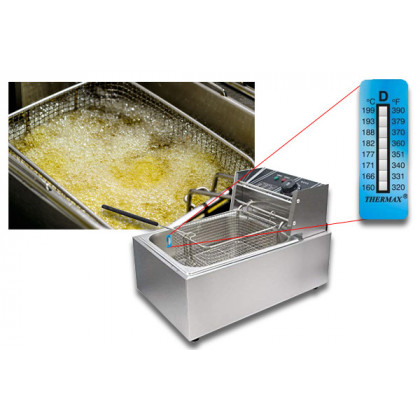Temperature control in deep fryers is essential since exceeding specific temperature limits alters the oil and reduces its durability. In addition, this generates some chemical compounds, such as acrylamide, that are harmful to the health of consumers of these fried foods.
For this reason, food companies must strictly control the temperature of the oil to avoid alterations in the food that will be consumed. But it is not only essential to control the temperature at which the food is fried, but also how often frying oil is changed and food hygiene during the process.
Temperature control methods for deep fryers
Deep fryers usually have thermostats that indicate the temperature. However, over time, the sensors on these thermostats deteriorate and can give false readings. This is why it is important to double‑check, as these thermostats may no longer be as accurate.
We can easily place irreversible thermometers, which have temperature sensors that change colour when the marked temperature is reached. Because they are irreversible, they permanently change colour. Therefore, we can fry food and check the reached temperature after we have finished. These temperature indicators are resistant to grease and oil; thus, they can be submerged without a problem.
This way, we can ensure that the fryer works correctly and that we are frying the food at the right temperature, thus preventing any issues. Additionally, temperature labels can serve as proof in quality control processes.
Frying temperature for crisps
Every potato variety usually has an ideal frying temperature to prevent the formation of acrylamide. In general, we should not exceed an oil temperature of 168 °C. If a higher temperature is needed, because it is a particular potato variety, this must be specified for the product.
Frying temperature for other products
As a general rule, the frying temperature will be between 160 °C and 175 °C. If we use the oven, it should be between 180 °C and 220 °C. In fryers that do not require oil, like air fryers, the appropriate temperature is between 180 °C and 220 °C, always following the instructions for the specific food. For this type of fryer, using temperature labels is also recommended as a method of checking the temperature. We need to bear in mind that poor temperature control can be detrimental to the quality of the food.
These labels can measure up to 290 °C, so they entirely cover the required spectrum. They are easy to use and very effective in determining whether the fryer exceeds the advisable temperature.
Vegetables, whether in tempura or batter, will need a temperature between 150 °C and 180 °C. Still, they must be fried less time than French fries. As for fried fish, it usually requires hotter oil, between 180 °C and 200 °C.
Frying temperatures depending on the oil used
Not only do we need to control the type of food to know what temperature the frying oil should reach. The type of oil used is also important. Olive oil is more stable and tends to retain the heat longer. Other oils, such as sunflower oil, cool down more quickly.
In short, temperature control in deep fryers must be carried out through a double check; the one provided by the actual fryer and an external control thermometer that warns us if the recommended temperature is exceeded. Producing fried products without health risks depends on this.

